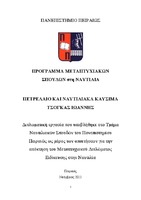| dc.contributor.advisor | Τζαννάτος, Ερνέστος | |
| dc.contributor.author | Τσόγκας, Ιωάννης | |
| dc.date.accessioned | 2015-07-22T13:11:45Z | |
| dc.date.available | 2015-07-22T13:11:45Z | |
| dc.date.issued | 2013-11 | |
| dc.identifier.uri | https://dione.lib.unipi.gr/xmlui/handle/unipi/6917 | |
| dc.description.abstract | Το πετρέλαιο είναι ένα υγρό καύσιμο, που έχει κατά την εποχή μας τη μεγαλύτερη διάδοση απ' όλα τα ορυκτά καύσιμα και είναι η σπουδαιότερη πηγή ενέργειας. Στην καθημερινή μας ζωή το πετρέλαιο εκτός όλων των υπολοίπων χρήσεων του, τροφοδοτεί εκατομμύρια κινητήρες εσωτερικής καύσης, που κινούν κυρίως τα μέσα συγκοινωνίας στην ξηρά, στον αέρα και στη θάλασσα. Έχει χρώμα καστανό ή σταχτοκίτρινο ή κάποτε και μελανό, ιδιάζουσα οσμή και ειδικό βάρος 0,85-0,86 κατά μέσο όρο, γιατί υπάρχουν πολλά είδη πετρελαίου, ανάλογα με τον τόπο εξαγωγής τους. Τα καύσιμα ναυτιλίας (marine fuel oil) ακόμα και σήμερα βασίζονται στα υπολείμματα απόσταξης του αργού πετρελαίου, τα οποία έχουν τη χαμηλότερη τιμή πώλησης και παρουσιάζουν φθίνουσα ζήτηση με την πάροδο του χρόνου με τις προδιαγραφές της αγοράς να θέτουν περιορισμούς κυρίως στο ιξώδες και την περιεκτικότητα σε θείο. Η προμήθεια καυσίμων από τη ναυτιλία και η επιθυμητή τους ποιότητα συμπυκνώνεται στο πρότυπο ISO 8217, το οποίο παρέχει προδιαγραφές τόσο για τη σειρά των ενδιάμεσων, υπολειμματικών καυσίμων (IFO series) όσο και για τα καύσιμα προϊόντα διύλισης αργού πετρελαίου (distillate marine fuels). Με δεδομένο ότι η κατανάλωση καυσίμων στις κύριες και βοηθητικές μηχανές αποτελούν περίπου το 50-60% του κόστους λειτουργίας ενός σύγχρονου πλοίου, έχουν καταβληθεί σημαντικές προσπάθειες για τον περιορισμό του κόστους αυτού μέσω της βελτιστοποίησης της γεωμετρίας της γάστρας και της υπερκατασκευής με στόχο τη μειωμένη αντίσταση πρόωσης, τη συνεργασία σκάφους-έλικας, τη διατήρηση καθαρών υφάλων με χρήση εξειδικευμένων, πολυμερών χρωμάτων, τη βελτίωση των μηχανών πρόωσης με μείωση της ειδικής κατανάλωσης καυσίμου, κ.α. Τα ναυτιλιακά καύσιμα σύμφωνα με το σχετικό ISO 8217 διακρίνονται σε δύο κατηγορίες: πετρέλαιο diesel και μαζούτ. | el |
| dc.format.extent | 87 | el |
| dc.language.iso | el | el |
| dc.publisher | Πανεπιστήμιο Πειραιώς | el |
| dc.rights | Attribution-NonCommercial-NoDerivatives 4.0 Διεθνές | * |
| dc.rights.uri | http://creativecommons.org/licenses/by-nc-nd/4.0/ | * |
| dc.subject | Πετρέλαιο ως καύσιμη ύλη | el |
| dc.subject | Πλοία -- Καύσιμα | el |
| dc.subject | Petroleum as fuel | el |
| dc.subject | Ships -- Fuel | el |
| dc.subject | Ships -- Fuel -- Environmental aspects | el |
| dc.subject | Ships -- Cost of operation | el |
| dc.title | Πετρέλαιο και ναυτιλιακά καύσιμα | el |
| dc.type | Master Thesis | el |
| dc.contributor.department | Σχολή Ναυτιλίας και Βιομηχανίας. Τμήμα Ναυτιλιακών Σπουδών | el |
| dc.identifier.call | 387.2 ΤΣΟ | el |
| dc.description.abstractEN | Petroleum is the fossil fuel that dominates our era's energy consumption and is in fact the world's no. 1 energy source. Nowadays in everyday life, petroleum is used besides all else, for providing the necessary energy for internal combustion engines that our used for inland, airborne and sea transportation of humans and goods. Its colour is dark brown or dark yellowish or even dark blue and its specific gravity varies but more or less around 0.85 - 0.86 depending always on the exporting country and the place of origin. Marine fuel oil even today are based on the residual distillates of crude oil, which have the lowest market based price, and a declining demand in terms of the market restrictions on the sulphur and viscosity of the product. Bunkering/Supply of Marine Fuels to vessels is based on the ISO 8217 which clearly states the specifications for the residual fuel oil and the distillate fuel oil. Given the fact that nowadays bunker consumption on the main and auxiliary engine are more or less 60% of the operating cost of a vessel, serious efforts are in progress in order to minimize the cost of fuels through better construction methods on the hull and reduced resistance on the body of the vessel, as well as less friction between vessel and propeller and using special ballast treatment with antifouling paints and last but not least the enhancement of design for engines with the aim to reduce fuel consumption. Marine fuel, as per ISO 8217 is divided in two major categories, heavy fuel oil and distillates. | el |
| dc.contributor.master | Ναυτιλία | el |



